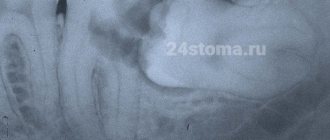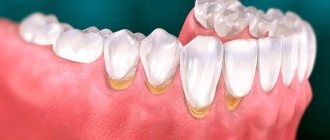Alcohol after dental treatment
The effect of alcohol on a treated tooth
How long after dental treatment can you drink alcohol?
Is it possible to drink carbonated or foamy drinks after dental treatment?
Is it possible to smoke after surgery?
A toothache can strike at the most unexpected moment, including before a planned feast. Is it possible to drink alcohol after dental treatment? What consequences can this lead to?
Indications
Let's figure out when the use of arsenic is acceptable and justified. Most often, arsenic paste is used when it is not possible to use other analgesics. This substance is used to kill nerve endings and blood vessels in the pulp. Arsenic paste can be used in the following situations:
- it is impossible to use another type of anesthesia due to the patient’s health condition (high blood pressure, alcohol intoxication);
- urgent emergency treatment and absence of other anesthetics;
- allergy to other painkillers;
- lack of effectiveness of other anesthetic drugs due to the patient’s high pain threshold;
- when treating baby teeth in children, when local anesthesia cannot be performed (the child is afraid of injections).
The effect of alcohol on a treated tooth
Some people think that alcohol after dental treatment additionally disinfects the oral cavity, but doctors say the opposite. After dental treatment, especially after treatment of pulpitis or periodontitis, the body needs rest. Not only the daily routine should be gentle, but also the diet, so at this time it is better to give up alcoholic beverages.
Let's tell you why.
- Alcohol can cause bleeding because alcohol dilates blood vessels and increases blood pressure.
- When drinking alcohol, the oral mucosa is irritated, the healing process slows down, and the risk of inflammation increases.
- Alcohol increases the load on the cardiovascular system and liver.
- Alcoholic drinks in combination with an anesthetic can cause headache, weakness, and convulsions.
Despite the fact that the effect of anesthesia wears off on average after two hours, the breakdown products continue to remain in the body for several more days.
Removal with arsenic
Once upon a time there was only one way to remove it, it was terribly painful, especially since you had to visit the doctor several times. At first, the doctor drilled the tooth down to the pulp with a drill, which was extremely painful. Next, arsenic was placed in the hole and it was temporarily sealed with a filling. In a couple of days, the arsenic dealt with the nerve, and the tooth hurt so much that no medicine could help. Then I had to go to the doctor again, he opened the temporary filling, removed the nerve, and cleaned the root canals. Pulp is a tenacious substance, so this process was also extremely painful.
This technology poses a certain danger, because arsenic is a poison, and the doctor, when using it, must be especially careful, and the patient must be careful: if you are late with the second visit to the doctor and leave arsenic in the tooth, it will completely destroy it, which will end deletion. Dentists stopped using arsenic and developed new techniques for removing pulp.
Is it possible to drink carbonated or foamy drinks after dental treatment?
Gas is a constant irritant to the tooth, and foamy drinks (for example, kvass) contain yeast, which can get into the wound and cause discomfort. In addition, in the first days after tooth extraction, it is not recommended to drink drinks from straws. When sucking any drink, a vacuum is created in the mouth, which can tear a blood clot out of the hole.
How long can you keep arsenic in your tooth?
You can only hold arsenic for a limited time. The exact time can be told by the dentist, who immediately after installing the drug schedules the next session. Typically, the chemical element takes from 16 to 48 hours to kill the nerve, the number of hours depends on the patient's age, dental condition, general health, method of applying arsenic, and the product that was used, since arsenic in its pure form is not used anywhere in dentistry. After the “work” of arsenic, mechanical removal of the tooth nerve is performed.
For adults
For a conditionally healthy adult, the drug is prescribed for a period of 1 to 2 days. In this case, an important role is played by the fact on which tooth the arsenic paste is installed, as well as what treatment method is used. Arsenic balls can be placed either on top of the closed pulp or inside after it has been opened. The first method is not very popular today and is practically not used, since very often such treatment only led to increased toothache. In such cases, arsenic could be given for 3 days, and sometimes more.
For 2 days, the paste is placed in a tooth with 2 roots, since it is necessary to remove a larger number of nerve endings, but in other cases, 24 hours is enough.
Caries - causes, prevention. How to brush your teeth correctly? Detailed instructions with Video! Teeth whitening at home is the most effective means.
For children
Children are more susceptible to poisons, so young patients under 18 years of age are given arsenic for less than a day. Typically, the time allotted for arsenic to act in a child’s body is from 16 to 24 hours. Therefore, it is extremely important for parents to take their child to the next appointment on time.
During pregnancy
During pregnancy, the use of arsenic for dental pain relief is contraindicated, since the introduction of poison into the body, even in small doses, can negatively affect the development of the fetus.
You should also stop using dental preparations based on arsenic during breastfeeding, since together with mother’s milk the substance enters the child’s fragile and unprepared body, which also causes serious harm to health, because up to 1.5 years of age, use potent drugs based on arsenic is prohibited.
Life time
The service life of a temporary filling varies from 3-4 days to 2-3 weeks. The exact timing depends on the specific dental disease and the drugs used in treatment.
Here's how much a temporary filling can cost in different situations:
- when using arsenic paste to kill a diseased nerve - no more than 2-3 days (usually 24-28 hours), when using other means (for example, paraform paste) for the same purposes - 5-10 days;
- when using antibiotics and antiseptics in the treatment of deep caries or pulpitis - from 3-4 days to 2-3 weeks;
- in particularly complex diagnostic cases – up to 3 and even 6 months.
If you can’t get to the doctor on time, be sure to notify him in advance. In this case, if possible, he will try to place the most durable reflective filling that can be safely worn for several months.
Types of temporary fillings
You cannot do without a temporary filling in the following cases:
- For conservative treatment of not too advanced pulpitis and advanced caries. After drilling out the inflammatory focus and treating the root canals, the tooth cavity is filled with anti-inflammatory drugs, and a filling is placed on top. This is necessary so that the drug does not leak out and that microbes and pieces of food do not get into the diseased tooth.
- For diagnosis in deep caries, when it is unclear whether the nerve is affected. They put a filling with medicine and watch the tooth - if it continues to hurt, most likely it is pulpitis.
- In the treatment of pulpitis, if there is a need to remove the nerve. Then the treatment is carried out in 2 steps: first, a filling is placed with arsenic or other, more gentle devitalizing drugs, and after the death of the nerve, treatment is carried out.
- For prosthetics and restoration to protect teeth while permanent structures are being made.
Installing a temporary filling is absolutely safe, except in cases where individual allergic reactions to filling materials are observed.
Is arsenic in the tooth harmful?
Although arsenic itself is a poison to the body and can be fatal, its use in dentistry is practically harmless. Modern arsenic-based products do not cause poisoning of the body even if the capsule enters the stomach.
In fact, such a remedy cannot cause fatal damage, but there are a number of points that indicate that arsenic cannot be called an absolutely safe remedy. First of all, this is noticeable by the fact that the use of an arsenic ball has a clearly limited time frame. Failure to comply with these deadlines will lead to the destruction of even healthy teeth, which is, without a doubt, a rather unpleasant consequence that disrupts the functional part of the oral cavity. At the same time, the destruction of crowns is not comparable to the fatal consequences of ordinary arsenic, therefore arsenic pastes can be called conditionally safe.
Potential problems
Problems that may arise after installing a temporary filling:
- Tolerable and not too severe toothache after filling is caused by several reasons: infection, the actual surgical intervention and incompletely killed pulp. But, if the pain is very severe, this may mean that the nerve is inflamed, periodontitis or pulpitis is developing, a cyst has formed, or there is an allergy to filling materials. In this case, only visiting a dentist will help.
- If the filling crumbles badly or falls out, you need to urgently run to the doctor, otherwise an infection will penetrate into the affected tooth and treatment will have to be started in the second round.
- Some antiseptic and medicinal preparations used in the treatment of dental canals have a distinct, specific taste. Therefore, a medicinal taste in the mouth for several days after filling is quite normal, albeit unpleasant. You can beat it off (or soften it) by rinsing. But, if the taste is very persistent, this may mean that the filling is cracked, and then you will still have to go to the doctor.
If the filling darkens, bad breath appears, the gums above (under) the affected tooth turn red or fester, you should also rush to the dentist.










